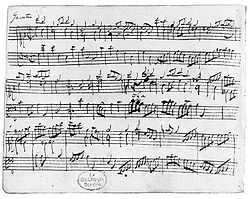Music manuscript

Music manuscripts are handwritten sources of music. Generally speaking, they can be written on paper or parchment. If the manuscript contains the composer's handwriting it is called an autograph. Music manuscripts can contain musical notation as well as texts and images. There exists a wide variety of types from sketches and fragments, to compositional scores and presentation copies of musical works.
Earliest music manuscripts
The earliest written sources of Western European music can be found in medieval manuscripts of the late 9th century that contain liturgical texts.[1] Above these texts small symbols (neumes) indicated the shape of the melodic lines. Only a few manuscripts survive from that time. New systems were devised over the centuries.[2]
Preparation of manuscripts and copying of music
In the distant past, each composer was required to draw their own staff lines (staves) onto blank paper. Eventually, staff paper was manufactured pre-printed with staves as a labor-saving technique. The composer could then compose music directly onto the lines in pencil or ink.
In the 20th century, music staff paper was often printed onto vellum or onionskin: a durable, semi-transparent paper which made it easier for the composer to correct mistakes and revise his work, and also enabled copies of the manuscript to be reproduced through the ozalid process. Also at this time, a music copyist was often employed to hand-copy individual parts (for each musician) from a composer's musical score. Neatness, speed, and accuracy were desirable traits of a skilled copyist.
With the advent of the personal computer in the late 1980s and beyond, music manuscript is becoming a lost art, as all of the "drawing" of each note, symbol, staff, written instruction, etc., can now be accomplished by a graphics computer software made for this purpose, such as Finale or Sibelius. Even individual parts of an orchestral score can be extracted and printed with this method. MIDI software is also available, which enables the composer to play notes, melodies, chords, etc. on a piano-type keyboard and have the result transcribed into manuscript format.
See also
References
External links
- http://www.freescores.weebly.com
- Répertoire International des Sources Musicales, free online database to search for current locations of thousands of music manuscripts from around the world
| |||||||||||||||||||||||||||